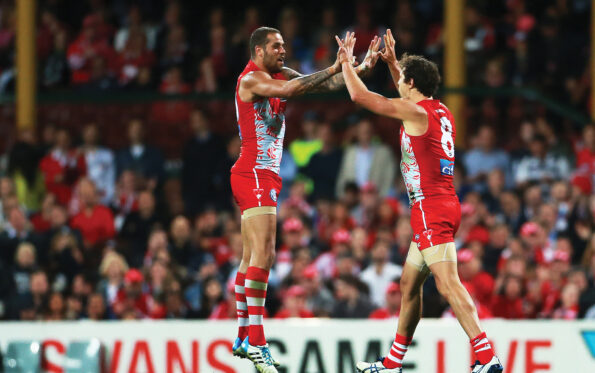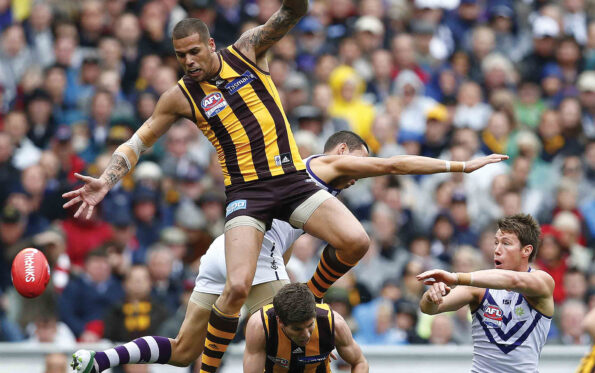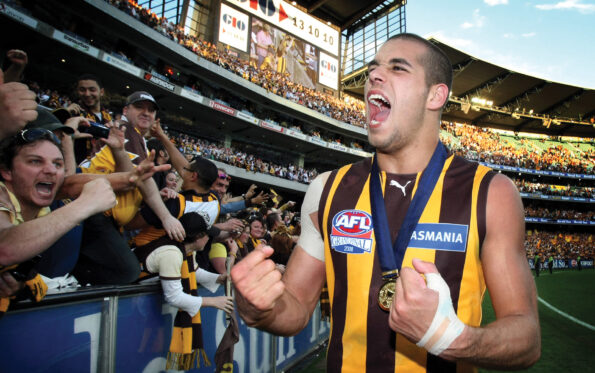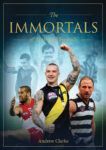New book The Immortals of Australian Football celebrates a collection of legendary players from the AFL and its predecessor, the VFL. This month, we look at the incredible career of one of the modern era greats, LANCE FRANKLIN…
When Lance Franklin kicked his 1000th AFL goal in 2022, James Brayshaw was calling the game, and he said, “The legend becomes Immortal.” There is an enduring image of Lance Franklin embracing the Hawthorn fans from a distance. He’d just kicked the winning goal in his first final against Adelaide, the last of seven on the day and three in the final quarter to carry the Hawks to an upset win. His long bomb sailed through the middle, and the long-starving Hawks fans were on their feet as Franklin faced them with arms spread.
I was in the stands that night with Byron, my three-year-old son, who was still buzzing an hour or so later when we made it home, waving his Hawks flag. His mother said she had never seen him like that, and we were not alone. Buddy had electrified the crowd, just as he did countless times during his more than 350 games and near 20-year career.
He dragged crowds through the gates and was a large part of Hawthorn’s success on and off the field, just as he was with Sydney when he joined the Swans in 2014 on a $10 million nine-year deal. The Swans say he was worth $11 million in membership sales in his first season.
The game has never seen a tall forward like him, and maybe never will again. He wasn’t flying over packs like Gary Ablett, but he was doing things Ablett could never do. On his good days, and there were many, there was nothing anyone could do to stop him. His ability at ground level was like that of a rover, and with those skills and his size, he was an impossible match-up. Even as a young player, he thrived in the battle and stood up to the challenge. Tall enough to be a ruckman, he started at 196 cm and ended at 199 cm. He was an athletic beast who could outrun most on the field. He spent his pre-seasons smashing his mates at Hawthorn and later Sydney in repeat sprints.
A Noongar man, Franklin grew up 170 km into the desert from Perth in Dowering, a town of only a few hundred people. His father was also Lance, and ‘Buddy’ was the nickname used to distinguish him from his father. To most, he is Buddy, and they aren’t even aware his real name is Lance. Buddy was the youngest of five kids and the only male in a sporting family. Lance Senior played hockey for Victoria, and his mother, Ursula, was an accomplished netballer in Perth and part of the Kickett family that has had a few AFL players.

All the Franklin kids were athletic, but it was Buddy who ran the girls into the ground. In a 2009 article in the Herald Sun, Bianca – an Australian netballer – spoke about her brother. “We were always outside (growing up)… and he was like an Energizer bunny,” she said. “We used to get sick of it because he could run all day, and I was like, ‘I’m over this’ (and go inside). Then you’d look out the window and there he was all by himself, kicking goal after goal.”
At primary school, he was adamant he was going to be an AFL star, and at 15, the first serious step was taken when he won a sporting scholarship to Wesley College in Perth and shot into the spotlight. The Herald Sun’s Jon Anderson visited the Australian Under-18 squad that was preparing to play Ireland, ostensibly to interview and photograph the expected – and eventual – number one draft pick for 2004, Brett Deledio. After the interview, Franklin said, “Hey, boys, you are speaking to the wrong player… it should be me.”
It was said in jest, with a huge grin, but his self-belief and confidence were often perceived as arrogance, and he could do the extraordinary because he believed he could. Fortunately for Hawthorn at the 2004 National Draft, that perception worked in its favour, and he was taken at pick number five. “There were a few question marks back then, a lot of clubs thought he was a bit over-confident and wondered how he would go in the new AFL environment and being in the limelight,” Hawthorn’s recruiting manager from 2004, Gary Buckenara, said in a story published on the AFL website in 2022. “He was confident enough as a kid. But that’s a good thing, I think. You want to see kids with belief in themselves. Buddy probably had a little bit of an extra strut or whatever in his step and in the way he handled himself, but I found him to be a really good lad.”
For the Hawks, Buddy was part of a super draft that brought his great mates Jarryd Roughead and Jordan Lewis to the club and played a key part in the resurgence that led first to the 2008 flag, and then the ‘three-peat’ from 2013, even if Buddy was only there for the first of the three. His star power was obvious early, and his freakish ability to kick goals from long range or in the wrong pocket was a feature of his career. In his second game of AFL football, he burst free from a pack on the 50 m line and headed to the boundary line, unloading a long bomb through the big sticks. A star was born.
It was far from the last time he’d kick a long goal, and in many respects, he was better from outside the 50 than inside, which led to the only knock on his game: inaccuracy. How about two goals 11 behinds against Western Bulldogs in a team score of 22 goals 19 behinds in an 84-point thumping two games before the 2007 finals? Eleven behinds is equal to the most scored in a game. The inaccuracy actually blunted what could have been one of his greatest games with 13 contested possessions, five of them marks. While he frustrated at times, he excited more often. Sixty metre goals? No worries. Seventy? He did that too. Baulk two, three or four opponents and still drop it in? Yep.

Some of his best goals make the eternal highlights list. His round-three 2013 leaping goal against Collingwood was one. A straight-up-the-middle kick-in from a behind went to future Hawks captain Ben Stratton who got a handball off while being taken to the ground in the centre circle by Sam Dwyer. Buddy at full speed took the pass and leapt over the two bodies on the ground to kick it through from 10m inside the centre square.
Then there was the famous pair of running goals down the left boundary line at the MCG against Essendon, goals number 334 and 335 in his career. The first was a two-bounce 30-metre run with Bomber Mark McVeigh chasing him, finishing with a dribble goal from just inside the 50. A few minutes later, it was a three-bounce sprint with a 40-metre run from the wing into the forward 50, and this time through quarter-post high. There are many, and the beauty of modern times is that all the goals have been captured on film. If you have a spare 20 minutes you can sit down and watch a package that features his first 1000 goals.
He was never too far from controversy, either. As the biggest name in the game, he could not go anywhere in public without a spotlight following him. Rumours abounded about behaviour, but there was never any basis to any of it, and it felt more like jealousy from opposition football fans who begrudgingly watched his highlights. His first season averaged around one goal per game. His second season approached two per game. His third season was three goals per game, and then his fourth was more than four goals per game and totalled 100 goals in the regular season.
In terms of goal output, that 2008 season was his peak. He won his first Premiership that year and sacrificed his own game in a game plan that he executed to perfection. He dragged Geelong full-back and dominant rebounder, Matthew Scarlett, out of the Hawks’ forward line. It blunted Geelong’s attack which often started with Scarlett. He did get two goals that day. Many said he didn’t perform in the big games, forgetting his previous four finals, which netted 19 goals.
After losing the 2012 Grand Final and preparing to enter a season with restricted free agency ahead, he agreed to terms to join Sydney, the team that had just beaten Hawthorn. The 2013 season was full of speculation, and most expected him to escape the Melbourne football bubble and join Greater Western Sydney on the biggest deal in AFL history. Instead of going to the fledgling team, he announced in the days after his second flag for Hawthorn that he was going to play for the Sydney Swans in a move which is rumoured to have been inspired more by the team’s marketing than its football department.
The deal was for $10m over nine seasons – it was the most lucrative in AFL history. It was a controversial deal that copped a lot of criticism. How could he play nine years when he was already beaten up? An early shoulder injury restricted his overhead marking, and he played a brutal combat style of game that had cut down many similar players who didn’t get much into their 30s. Hawthorn could have matched the offer and forced Sydney to negotiate a trade, but it let its champion go. Sydney had its man and its forward figurehead, which was so important to its marketing in the non-AFL city.
“I’ve come here to do nothing else besides win premierships, that’s what I’m here for,” Franklin told News Limited as he was unveiled as a Swan. “I’ve got family and I’ve got friends here but most of all I’ve got a football club now.” Ironically, at Sydney, he played in the next Grand Final against Hawthorn and was monumental, but even that was not enough as Hawthorn exacted revenge for the 2012 loss. He played in two more Grand Finals after that with the Swans, losing both and leaving him with a two-three record in the big game. He is third on the list of goal scorers in finals series, with 72 from 28 finals games, trailing only Gordon Coventry and Jason Dunstall.

In Sydney, the theory was that he went there to escape the spotlight, but given his marketing power, nothing could be further from the truth. In his first season with the Swans, his face was everywhere, they had the biggest name in the game, and they were making it work. The Sydney Cricket Ground started to sell out on a regular basis, and Buddy was the star of the show.
His brilliance was universally recognised as he broke records and left a mark on the game. When he passed 350 games in 2023 the accolades flowed. A former Premiership teammate at Hawthorn, Brad Sewell, in The Inner Sanctum, 2023, said of his teammate from 2005 to 2012, “He was never really arrogant, but he had an underlying confidence that only the best players have. I want to say he’s naturally talented and gifted, but that does a disservice to just how hard he works. He was an incredible trainer, I can still remember some of the running sessions he put himself through. He’s an incredible competitor, he had a huge work ethic, and that only helped to build on the talents he was given.”
On the stats side, Daniel Hoevenaars (Insight Lane), analyses goals based on the goal scoring of the era, much like seasonally-adjusted unemployment figures. Under Hoevenaars’ system, Franklin is the greatest goal scorer in the entirety of the VFL and AFL. On his data, with goals harder to score in this millennium than previously, Franklin moved past Lockett at the head of the table during round 19 of 2023, one game before a calf injury brought a premature end to his career. On adjusted figures, Lockett dropped to a career tally of 1209 (down from 1360), and Franklin passed him with 1211 goals (up from 1066). While not factual, the measure is interesting and highlights his impact in the game.
Along with Polly Farmer, he is the greatest Indigenous footballer to ever play. He remains a role model in his community and is proud of his heritage. He has played with some of the best too. Cyril Rioli and he had a special X-factor bond on the field, and Adam Goodes in Sydney played many games with him. In 2017 he wore the number 67 in a game to celebrate the referendum in 1967, which changed two sections of the constitution to grant Indigenous Australians the same rights as white people.
Many think he will be the last player ever to kick 100 goals in a season and that he will also be the last to kick more than 1000 in a career. The way the game is currently played, that may be true, but things change and anything is possible. His final game ended on the bench as speculation was swirling around another season because his form was so good at the time. He announced his retirement with the simple social media message: “What a journey. Thanks to everyone who has been on this crazy ride with me.”
And there it was, 18 years and 126 days after he played his first game, one of the greatest careers in more than 130 years of VFL and AFL football had ended with 182 games at Hawthorn and 172 at Sydney. He locked in 1066 goals at 3.01 a game which was 0.5 goals a game better than the next best of those playing in 2023. The stats were impressive, but it is the memories that will last.

This is an edited extract from The Immortals of Australian Football by Andrew Clarke (Gelding Street Press, $39.99) available at BIG W and all good bookstores
By ANDREW CLARKE
ALL PHOTOS: © NEWSPIX
For the full article grab the September 2024 issue of MAXIM Australia from newsagents and convenience locations. Subscribe here.




